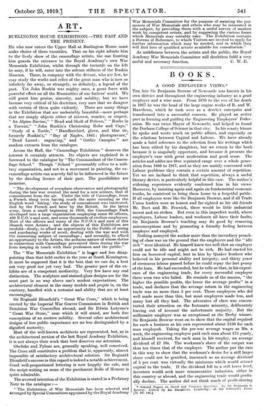ART.
BURLINGTON HOUSE EXHIBITIONS.—THE PAST AND THE PRESENT.
HE who now enters the Upper Hall at Burlington House must. make choice of three turnstiles. That on his right admits him
to the lively show of the camouflage artists, the one fronting him guards the entrance to the Royal Academy's own War Memorials Exhibition, whilst through the turnstile on the left he may, if he will, enter into the solemn stillness of the Ruskin Museum. There, in company with the devout, who are few, he may study the works and relics of the great man who is now so infinitely far away, so strangely, so definitely, a legend of the past. Yet John Ruskin was mighty once, a great force with powerful effect on all the Humanities of our fathers' world. We still grant him genius, sincerity, and nobility, but we have become very critical of his doctrines, very sure that we disagree with certain of them quite violently. There are many things in the Exhibition that are undeniably beautiful—more perhaps that are simply objects either of interest, wonder, or respect. " An Alpine Ravine," " Head and Skull of Pelican," " Rocks in a Torrent," " John Ruskin's Christening Robe and Caps," Study of a Turtle," " Handkerchief, glove, and blue tie, formerly Ruskin's," "Bay of Naples, 1841: photogravure," " Dead Laurel : engraving," and " Gothic Canopies " are random extracts from the catalogue.
Across the Hall, the " Camouflage Exhibition " deserves the interest it certainly attracts. Its objects are explained in a
foreword to the catalogue by "The Commandant of the Camouflage School." Though " School " presumably refers to a mili tary organization, and not to a movement in painting, the excamouflage artists can scarcely fail to be influenced in the future by the dazzling licence of their past. The possibilities are immense.
" The development of aeroplane observation and. photography during the late war created the need for a new science, that of concealment from the air. Under the title of Camouflage, from a. French slang term having much the same meaning as the English word ' faking,' the study of concealment was instituted, first by the French and later by the British. In the latter army, from a small beginning in 1916, the Camouflage Park developed into a large organization employing some 60 officers, 400 N.C.O.'s and men, and some thousands of civilian employees. Most of the officers and many of the N.C.O.'s and men of this Branch were Artiste ; and the objects of this Exhibition are twofold—firstly, to afford an opportunity to the Public of seeing and purchasing works of merit, dealing with the war and with the interesting subject of camouflage ; and secondly, to afford an opportunity to the Artists, the arduous nature of whose duties in connection with Camouflage prevented them during the war from keeping in touch with their profession and the public."
The " War Memorials Exhibition " is lasfer and less disappointing than that held earlier in the year at South Kensington. It must be supposed that it is the best that we can do, a best not very good nor yet very bad. The greater part of the exhibits are of a competent mediocrity. Very few have any real
distinction. The sculpture and stained-glass designs are for the most part in no way above one's modest expectations. The
architectural element in the many models and projets is, on the contrary, handled with a restraint and ability that are at least
encouraging.
Sir Reginald Blomfield's " Great War Cross," which is being erected by the Imperial War Graves Commission in British and Dominion War Cemetelies abroad, and Sir Edwin Lutyens's Great War Stone," near which it will stand, are both fine conceptions of an austere nobility. Several other architectural designs of less public importance are no less distinguished by a dignified austerity.
Most of the well-known architects are represented, but, as in the architectural section of the last Royal Academy Exhibition, it is not always their work that best deserves our attention.
Obelisks and Pylons are, generally speaking, well conceived.
The Cross still constitutes a problem that is, apparently, almost impossible of satisfactory architectural solution. Sir Reginald Blomfield's success in this regard is indeed a notable achievement. Good well-proportioned lettering is now happily the rule, and the script-writing on some of the parchment Rolls of Honour is quite admirable.
The avowed intention of the Exhibition is stated in a Prefatory Note to the catalogue :
" The Exhibition of War Memorials has been selected and arranged by Special Committees appointed by the Royal Academy
War Memorials Committee for the purpose of assisting the promoters of War Memorials and others who may be interested in the subject, by providing them with a useful survey of modern work by competent artists, and by suggesting the various forms which Memorials may suitably take. The Exhibition contains a Bureau of Reference, to which Visitors are invited to apply for further information which may be needed, and in which they will find lists of qualified artists available for consultation."
As middlemen between the artists and the public, the Royal Academy War Memorials Committee will doubtless fulfil a very useful and necessary function. C. W.-E.










































 Previous page
Previous page